Discover 35 hidden attractions, cool sights, and unusual things to do in Quincy (United States). Don't miss out on these must-see attractions: Adams National Historical Park, United First Parish Church, and John Adams Birthplace. Also, be sure to include USS Salem in your itinerary.
Below, you can find the list of the most amazing places you should visit in Quincy (Massachusetts).
Table of Contents
Adams National Historical Park
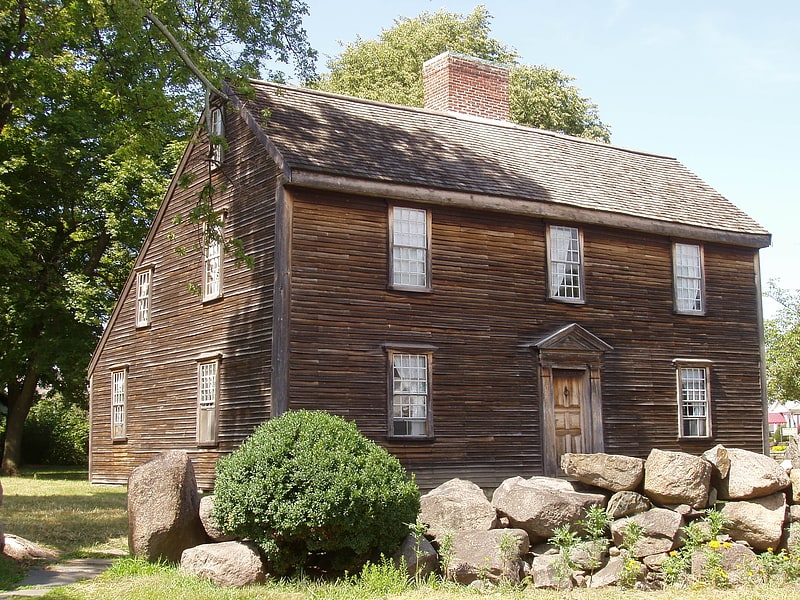
Protected site in Quincy, Massachusetts. Adams National Historical Park, formerly Adams National Historic Site, in Quincy, Massachusetts, preserves the home of United States presidents John Adams and John Quincy Adams, of U.S. envoy to Great Britain Charles Francis Adams, and of writers and historians Henry Adams and Brooks Adams.
The national historical park's eleven buildings tell the story of five generations of the Adams family (from 1720 to 1927) including presidents, first ladies, envoys, historians, writers, and family members who supported and contributed to their success. In addition to Peacefield, home to four generations of the Adams family, the park's main historic features include the John Adams Birthplace (October 30, 1735), the nearby John Quincy Adams Birthplace (July 11, 1767), and the Stone Library (built in 1870 to house the books of John Quincy Adams and believed to be the first presidential library), containing more than 14,000 historic volumes in 12 languages.
There is an off-site Visitors Center less than a mile (1.6 km) away. Regularly scheduled tours of the houses are offered in season (April 19 to November 10) by guided tour only, using a tourist trolley provided by the Park Service between sites. Access to United First Parish Church, where the Adamses worshipped and are buried, is provided by the congregation, for which they ask a small donation. The church is across the street from the Visitors Center.[1]
Address: 135 Adams St, 02169-1749 Quincy (Quincy)
United First Parish Church
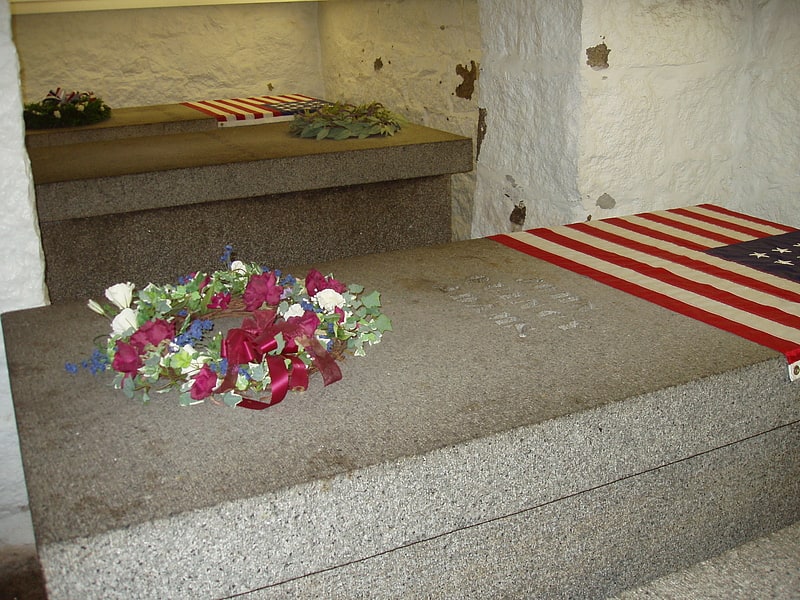
Parish church in Quincy, Massachusetts. United First Parish Church is a Unitarian Universalist congregation in Quincy, Massachusetts, established as the parish church of Quincy in 1639. The current building was constructed in 1828 by noted Boston stonecutter Abner Joy to designs by Alexander Parris. The building was designated a National Historic Landmark on December 30, 1970, for its association with the Adams family, who funded its construction and whose most significant members are interred here.
It is called the Church of the Presidents because two American Presidents, John Adams and John Quincy Adams, attended the church along with their wives, Abigail Adams and Louisa Catherine Adams. All four are interred beneath the church in a family crypt. The pew in which they sat is marked with a plaque and ribbon on the side.[2]
Address: 1306 Hancock St, 02169-5112 Quincy (Quincy)
John Adams Birthplace
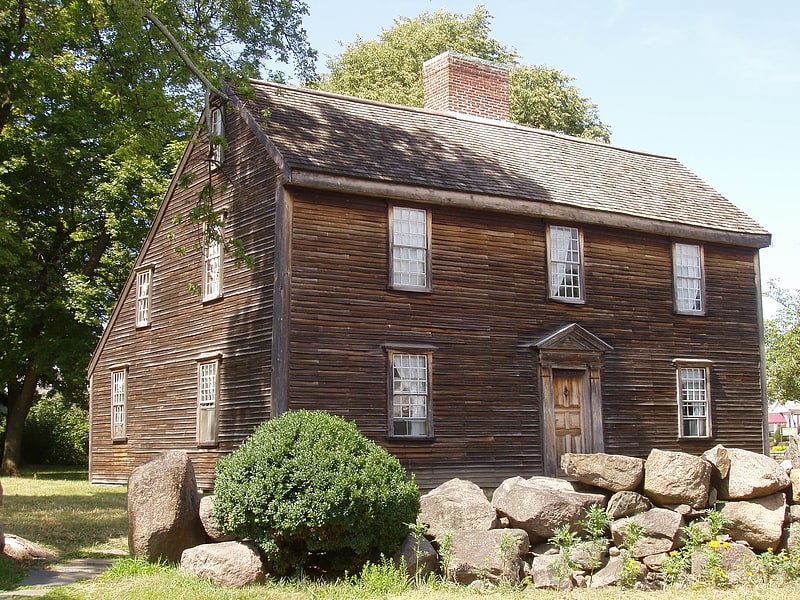
The John Adams Birthplace is a historic house at 133 Franklin Street in Quincy, Massachusetts. It is the saltbox home in which the second president of the United States, John Adams, was born in 1735. The house was designated a National Historic Landmark in 1960, and is listed on the National Register of Historic Places. It is now administered by the National Park Service as part of the Adams National Historical Park, and is open for guided tours.[3]
Address: 141 Franklin St, 02169 Quincy (Quincy)
USS Salem
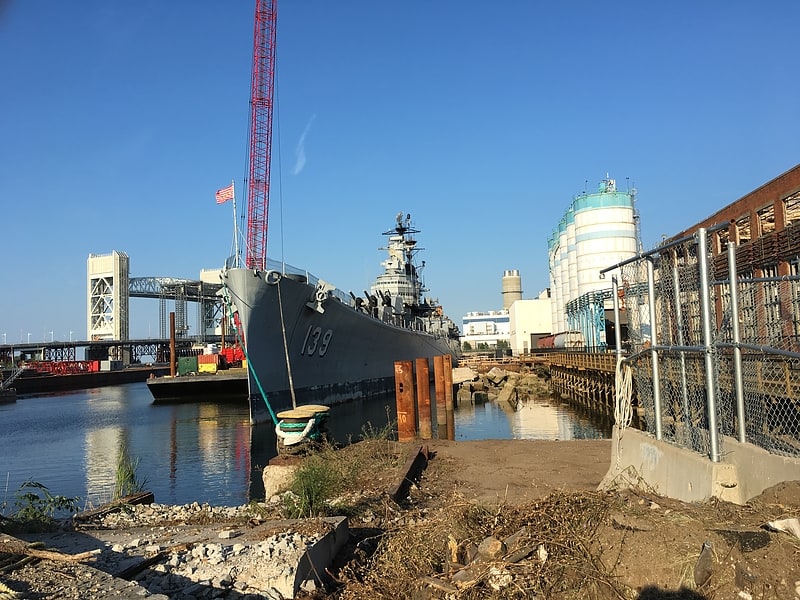
Naval museum on a heavy cruiser ship. USS Salem is a Des Moines-class heavy cruiser completed for the United States Navy shortly after World War II and commissioned in 1949. The second ship of her class, she was the world's last heavy cruiser to enter service and the last remaining. She was decommissioned in 1959 after serving in the Atlantic and Mediterranean. She is open to the public as a museum ship in Quincy, Massachusetts.[4]
Address: 739 Washington St, 02169-7330 Quincy (Quincy)
United States Naval Shipbuilding Museum

Museum in Norfolk County. The United States Naval Shipbuilding Museum is a private non-profit museum in Quincy, Massachusetts featuring USS Salem, a heavy cruiser docked at the former Fore River Shipyard where she was laid down in 1945. The museum was established in 1993, in response to efforts by local officials and volunteers to revive the shipyard area after operations at Fore River ended in 1986. Several exhibits are on board Salem relating to United States naval history and shipbuilding. Before being moved to a different pier, the museum featured dockside fixtures and a miniature golf course.[5]
Address: 739 Washington St, 02169-7330 Quincy (Quincy)
Dorothy Quincy Homestead
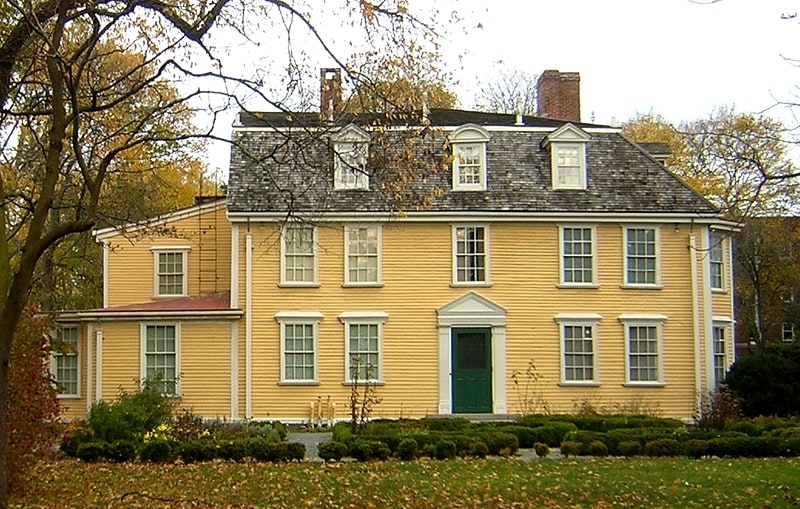
Museum in Quincy, Massachusetts. The Dorothy Quincy Homestead is a US National Historic Landmark at 34 Butler Road in Quincy, Massachusetts. The house was originally built by Edmund Quincy II in 1686 who had an extensive property upon which there were multiple buildings. Today, the site consists of the Dorothy Quincy Homestead, which has been preserved as a museum and is open occasionally to the public.[6]
Address: 34 Butler Rd, 02169-2212 Quincy (Quincy)
Quincy Quarries
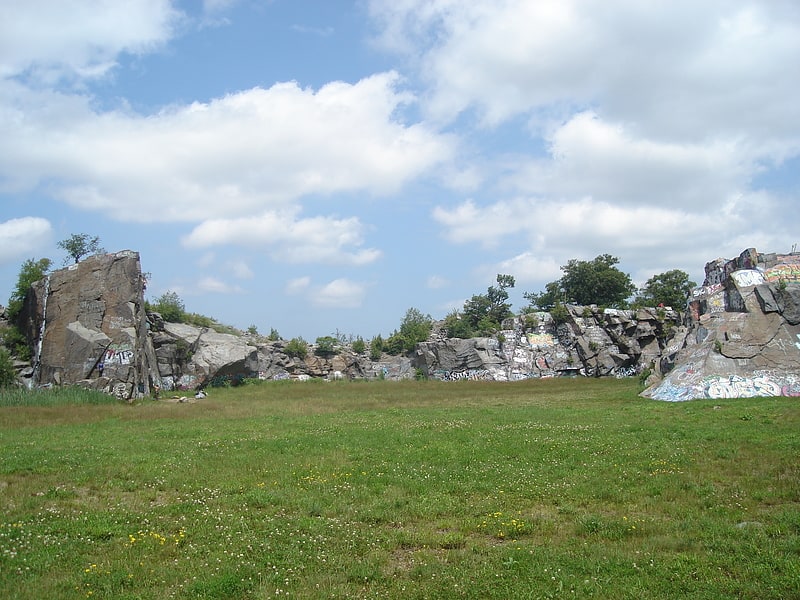
State park in Quincy, Massachusetts. The Quincy Quarries in Quincy, Massachusetts, produced granite for over a century and were the site of the Granite Railway—often credited as being the first railroad in the United States. A 22-acre section of the former quarries is owned and operated by the Massachusetts Department of Conservation and Recreation as a public recreation area.[7]
Address: 93 Ricciuti Dr, 02169 Quincy (Quincy)
Hancock Cemetery

Cemetery in Quincy, Massachusetts. Hancock Cemetery is a historic cemetery on Hancock Street in Quincy Square, across the street from the United First Parish Church in Quincy, Massachusetts, United States. It is named after Reverend John Hancock, father of Founding Father John Hancock.
The cemetery was founded c. 1640 (the date of the earliest documented graves), and is the only tangible remainder of the early settlement of the area. It was the resting place of Presidents John Adams and John Quincy Adams and their wives, Abigail Adams and Louisa Adams (respectively), before they were moved to the crypt in the United First Parish Church.
The cemetery was listed on the National Register of Historic Places in 1982.
The cemetery markers and graves have recently been digitized on Google Maps and Google Earth.[8]
Address: 1307 Hancock St, 02169-5119 Quincy (Quincy)
Squantum Point Park
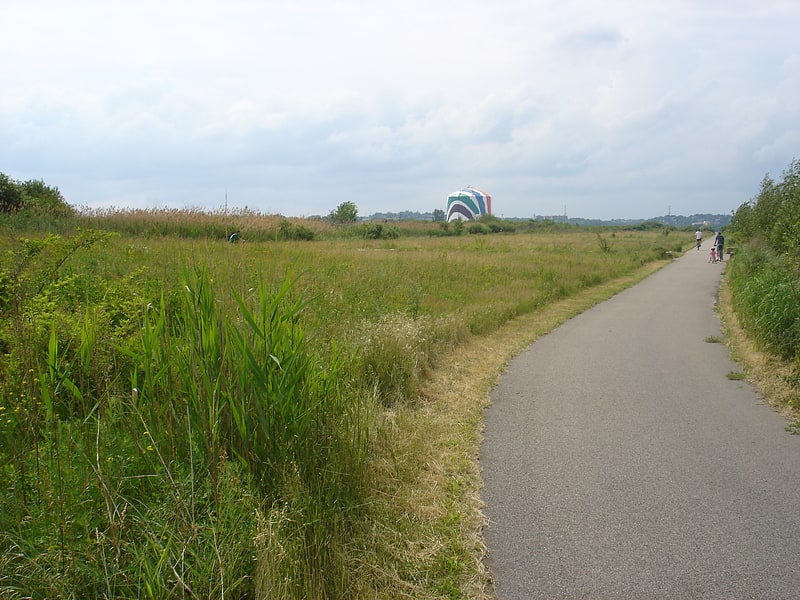
State park in Quincy, Massachusetts. Squantum Point Park is a state-owned, public recreation area located on the Squantum peninsula of Quincy, Massachusetts, United States. The park was created on the site of the former Squantum Naval Air Station, which is preserved in a 2,700-foot-long strip of runway, and the former dockworks of the Bethlehem Shipbuilding Corporation. The park is managed by the Massachusetts Department of Conservation and Recreation and is associated with the development of the Neponset River Reservation.[9]
Address: 1 Victory Rd, Quincy (Quincy)
Quincy Historical Society
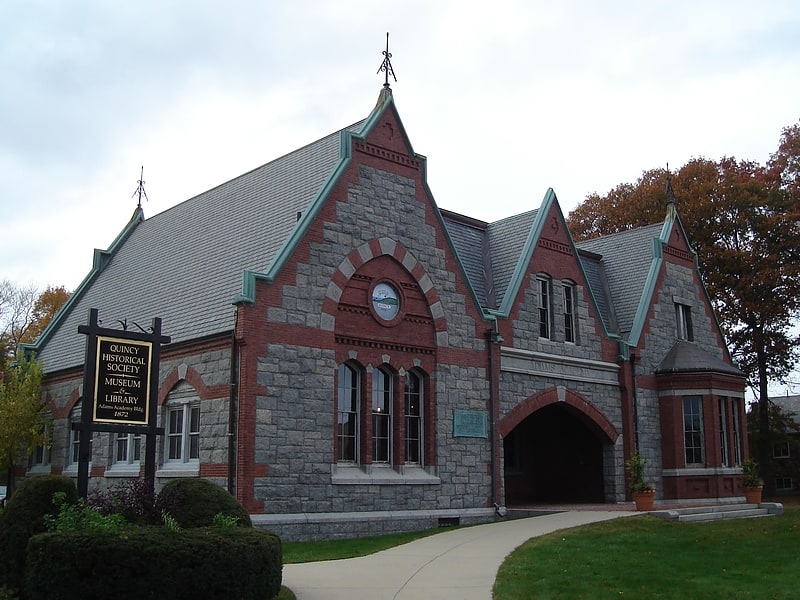
Museum in Quincy, Massachusetts. The Quincy Historical Society is located at 8 Adams Street in Quincy, Norfolk County, Massachusetts, United States. It was founded in 1893 by Charles Francis Adams, Jr. Dr. Edward Fitzgerald is the executive director.
The society occupies the former Adams Academy building. The building was designed by Henry Van Brunt and William Robert Ware, the latter of whom was the architect of the Episcopal Divinity School in Cambridge, Massachusetts, built in 1869, has been listed on the National Register of Historic Places since 1974, and was designated a National Historic Landmark in 1994.
The Society's Quincy History Museum features exhibits about the community's social and cultural history, including Native Americans, the Colonial era, President John Adams and his family, area shipbuilders and granite workers, and local entrepreneurs and businesses, such as Howard Johnson.
The Quincy History Museum & shop are open Mon-Fri 9-4 year-round, Saturdays 12–3 April 14 through November 10. The library is open Monday through Friday, 9-12 and by appointment, year-round. It is closed on holidays.[10]
Address: 8 Adams St, 02169-2002 Quincy (Quincy)
Thomas Crane Public Library
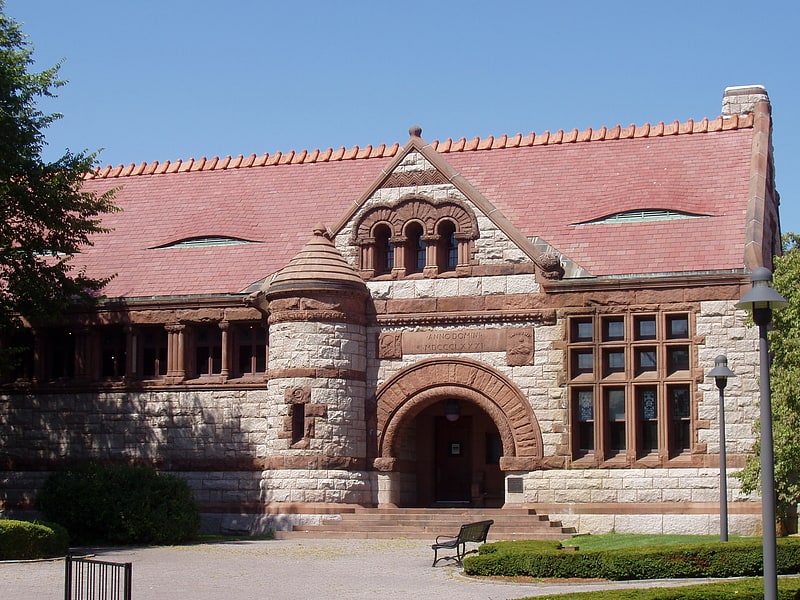
City library in Quincy, Massachusetts. The Thomas Crane Public Library is a city library in Quincy, Massachusetts. It is noted for its architecture. It was funded by the Crane family as a memorial to Thomas Crane, a wealthy stone contractor who got his start in the Quincy quarries. The Thomas Crane Library has the second largest municipal collection in Massachusetts after the Boston Public Library.
In fiscal year 2008, the city of Quincy spent 1.41% ($2,690,878) of its budget on the library—some $29 per person.[11]
Address: 40 Washington St, 02169-5346 Quincy (Quincy)
Peacefield
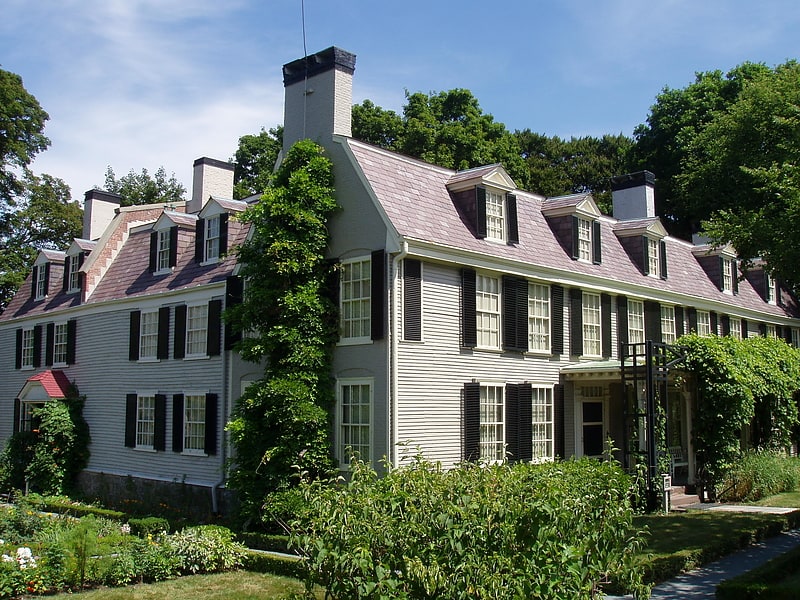
Historical place museum in Quincy, Massachusetts. Peacefield, also called Peace field or Old House, is a historic home formerly owned by the Adams family of Quincy, Massachusetts. It was the home of United States founding father and U.S. president John Adams and First Lady Abigail Adams, and of U.S. president John Quincy Adams and his First Lady, Louisa Adams. It is now part of the Adams National Historical Park.
The Stone Library requested by John Quincy Adams is directly next door. It was built by John Quincy's son Charles, a Peacefield resident, after the deaths of the two presidents.[12]
Address: 135 Adams St, Quincy (Quincy)
Quincy Shore Reservation
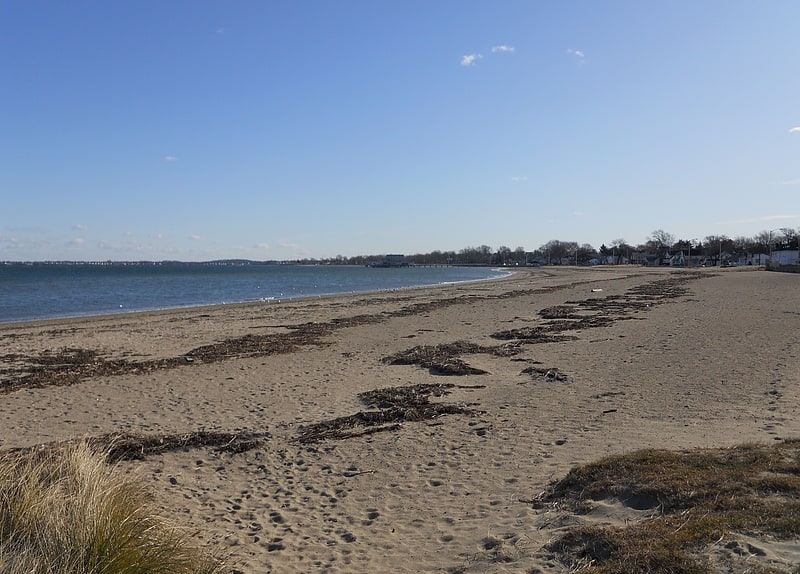
Park in Quincy, Massachusetts. Quincy Shore Reservation is a public recreation area and protected shoreline on Quincy Bay, Boston Harbor, in Quincy, Massachusetts. Its primary attraction is a 2.3-mile-long beach, accessible along its entire length by Quincy Shore Drive. The largest beach on Boston Harbor, it is known locally as Wollaston Beach, named for the adjacent Wollaston neighborhood.
The reservation is part of the Metropolitan Park System of Greater Boston and was established in 1889. Also included in the reservation are Moswetuset Hummock, site of the first encounter of Plymouth Colony commander Myles Standish with the local native sachem, or leader, Chickatawbut in 1621 and cited as a source for the name of Massachusetts; and Caddy Park, a preserved salt marsh with nearby picnic facilities.[13]
Josiah Quincy House

Historical place museum in Quincy, Massachusetts. The Josiah Quincy House, located at 20 Muirhead Street in the Wollaston neighborhood of Quincy, Massachusetts, was the country home of Revolutionary War soldier Colonel Josiah Quincy I, the first in a line of six illustrious Josiah Quincys that included three Boston mayors and a president of Harvard University.
Having inherited the land from father Edmund, Josiah built his mansion on a 200-acre (81 ha) farm called the "Lower Farm," which had been in the family since 1635. The house was built in 1770 and was originally surrounded by fields and pasture overlooking Quincy Bay. It is constructed with an unusual hipped monitor roof, the oldest known example of this roof style to survive from the original colonies, and includes a Chinese fretwork balustrade and classical portico. Its attic contains four small rooms for servants, one with a fireplace.
During the American Revolution, Quincy aided General George Washington by observing the British fleet in Boston Harbor from his attic windows. He scratched on a pane of glass in the attic, "October 10, 1775 Governor Gage saild for England with a fair wind." That glass pane has been preserved and now on view in the front hall.
In 1895, the house and some adjoining properties were sold to Frank E. Hall of Boston. In 1937, Edward R. Hall arranged for the Josiah Quincy House to become the property of the Society for the Preservation of New England Antiquities. The house is now owned by Historic New England, a non-profit historical organization, and is open only four Saturdays a year and by special appointment. It was designated a National Historic Landmark in 1997 for its architectural significance and for its association with the Quincy family.[14]
Address: 20 Muirhead St, Quincy (Quincy)
Chickatawbut Observation Tower
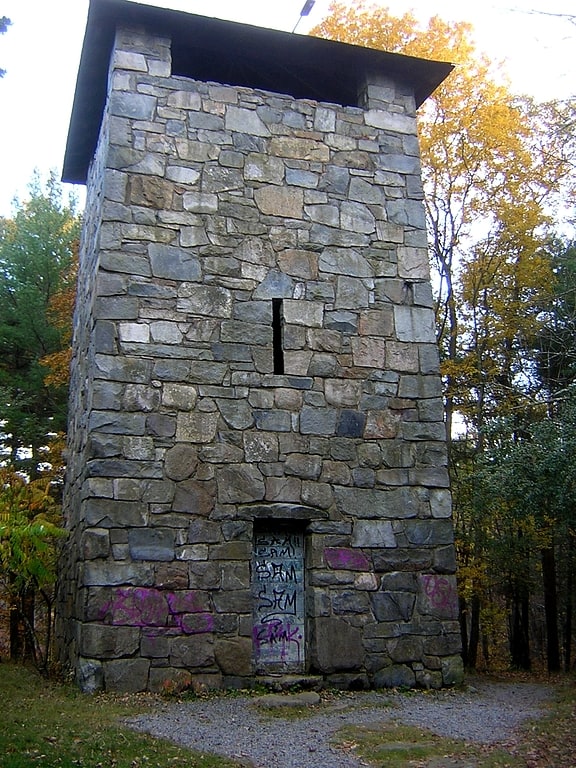
Tower in Quincy, Massachusetts. The Chickatawbut Observation Tower is a historic tower on Chickatawbut Road in Quincy, Massachusetts, in the Blue Hill Reservation, a Massachusetts state park.
Unlike Great Blue Hill Observation Tower, a similar tower at the opposite end of the reservation, Chickatawbut tower is not open to the public. The tower was built by the Civilian Conservation Corps in the 1930s. It is named for Chickatawbut, who was a 17th-century sachem of the Wampanoag Indian tribe.
The tower was added to the National Register of Historic Places in 1980.[15]
Christ Church
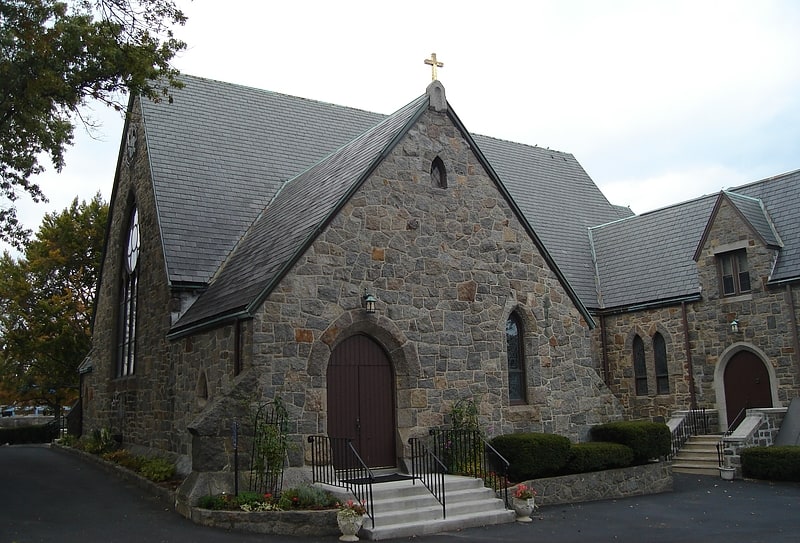
Episcopal church in Quincy, Massachusetts. Christ Church is a historic church in Quincy, Massachusetts. It is a parish of the Episcopal Diocese of Massachusetts. The parish first congregated for lay-led services in 1689, and officially formed in 1704. It is believed to be the oldest continuously active Episcopal parish in Massachusetts. The building is a Tudor Revival structure constructed in 1874; it was listed on the National Register of Historic Places in 1989. The Rev. Clifford Brown is the current rector.[16]
Address: School Street, 02169 Quincy (Quincy)
Quincy City Hall

Building in Quincy, Massachusetts. Quincy City Hall is the seat of government for the City of Quincy, Massachusetts. The historic town hall building at 1305 Hancock Street in Quincy Center was built in 1844. It is a somewhat monumental example of Greek Revival architecture, featuring a temple front with two-story Ionic pilasters and a triangular pediment. Elements of the main facade were significantly altered when the town was converted to a city in 1888. It has been the seat of local government since its construction.
The building was listed on the National Register of Historic Places in 1980 (as "Quincy Town Hall").[17]
Address: 1305 Hancock St, Quincy (Quincy)
Bethany Congregational Church
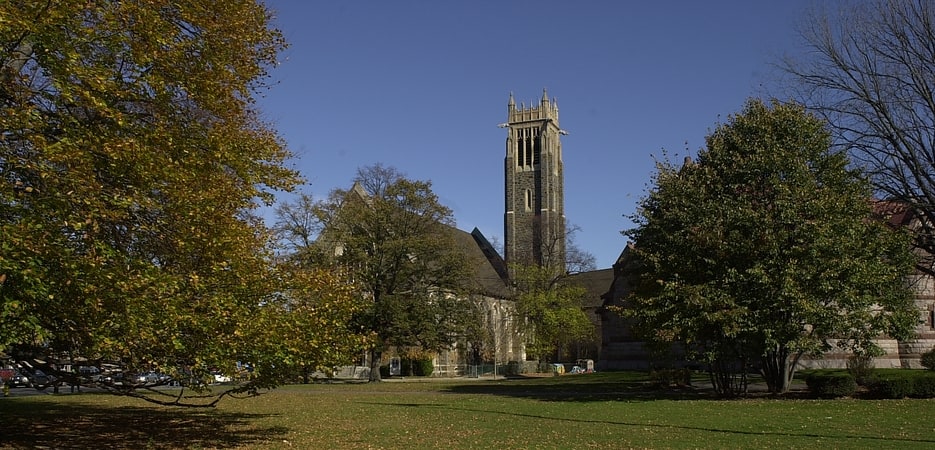
Church building in Quincy, Massachusetts. Bethany Congregational Church is a historic Congregational church building at 18 Spear Street in Quincy, Massachusetts. The Gothic Revival building was designed and built in 1927 to a design by J. Williams Beal, Sons, for a congregation which was established in 1832. The building was listed on the National Register of Historic Places in 1989. Services are held every Sunday at 9:30 AM. All are welcome.[18]
Address: 18 Spear St, 02169 Quincy (Quincy)
Fort Andrews
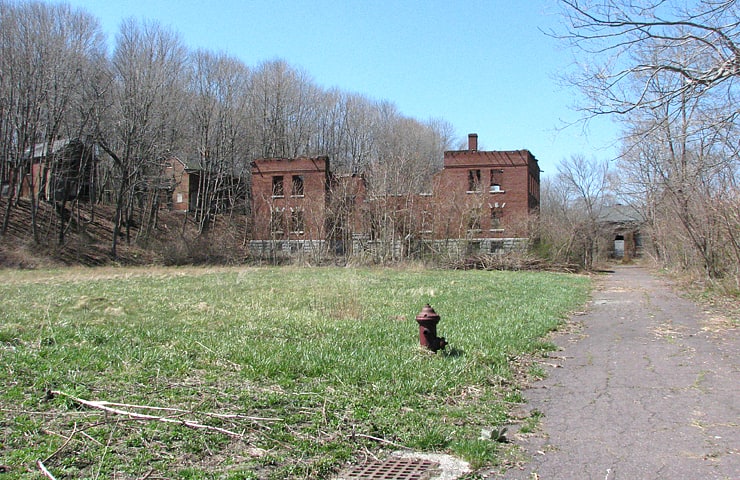
Historical landmark in Hull, Massachusetts. Fort Andrews was created in 1897 as part of the Coast Defenses of Boston, Massachusetts. Construction began in 1898 and the fort was substantially complete by 1904. The fort was named after Major General George Leonard Andrews, an engineer and Civil War commander, who assisted in the construction of nearby Fort Warren in Boston Harbor. It occupies the entire northeast end of Peddocks Island in Boston Harbor, and was originally called the Peddocks Island Military Reservation. Once an active Coast Artillery post, it was manned by hundreds of soldiers and bristled with mortars and guns that controlled the southern approaches to Boston and Quincy Bay. The fort also served as a prisoner-of-war camp for Italian prisoners during World War II, who were employed as laborers following the Italian surrender to the Allies in 1943. Today, the fort is abandoned, and is managed by the Massachusetts Department of Conservation and Recreation, as part of the Boston Harbor Islands National Recreation Area.[19]
Furnace Brook Parkway
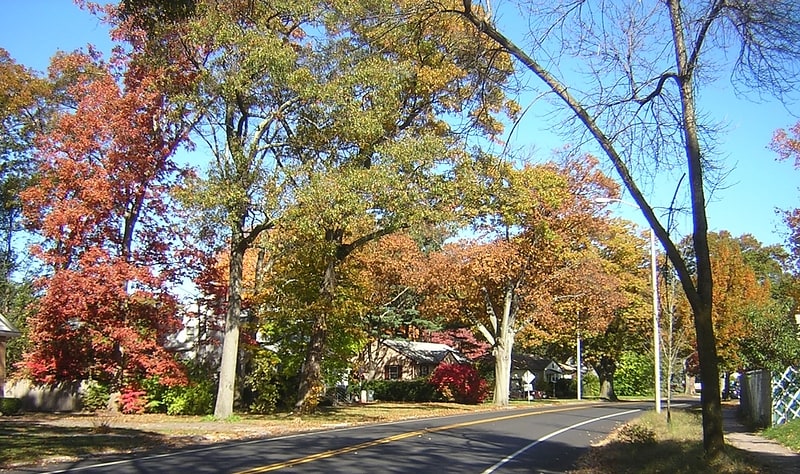
Road in Quincy, Massachusetts. Furnace Brook Parkway is a historic parkway in Quincy, Massachusetts. Part of the Metropolitan Park System of Greater Boston, it serves as a connector between the Blue Hills Reservation and Quincy Shore Reservation at Quincy Bay. First conceived in the late nineteenth century, the state parkway is owned and maintained by the Massachusetts Department of Conservation and Recreation and travels through land formerly owned by the families of John Adams and John Quincy Adams, passing several historic sites. It ends in the Merrymount neighborhood, where Quincy was first settled by Europeans in 1625 by Captain Richard Wollaston. The road was started in 1904, completed in 1916 and added to the National Register of Historic Places in 2004.
Furnace Brook Parkway approximately bisects central Quincy on a southwest–northeast line, following closely the courses of Furnace Brook and Blacks Creek, the estuary into which the brook flows, crossing them several times. For the majority of its length it is two lanes undivided, with the exception of directional lanes at a traffic circle (called a "rotary" in New England) where it meets Interstate 93.[20]
Adams National Historical Park
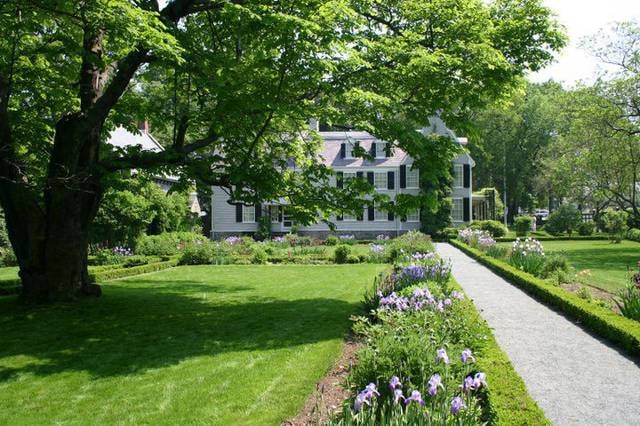
Building in Quincy, Massachusetts. The Adams Building is a historic commercial building at 1342–1368 Hancock Street in downtown Quincy, Massachusetts. Built in stages between 1880 and 1890, it is a distinctive example of Jacobethan architecture, and is one of city's oldest commercial buildings. It was owned for many years by members of the politically prominent Adams family. The building was listed on the National Register of Historic Places in 1983.[21]
Address: 1250 Hancock St, 02169-4339 Quincy (Quincy)
John Quincy Adams Birthplace
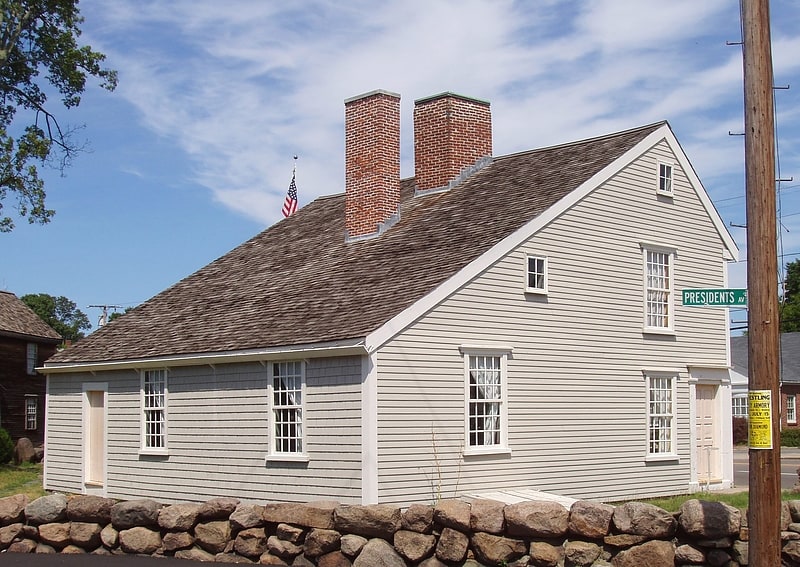
The John Quincy Adams Birthplace is a historic house at 141 Franklin Street in Quincy, Massachusetts. It is the saltbox home in which the sixth United States President, John Quincy Adams, was born in 1767. The family lived in this home during the time John Adams helped found the United States with his work on the Declaration of Independence and the American Revolutionary War. His own birthplace is only 75 feet away, on the same property.
Both houses are National Historic Landmarks, and part of Adams National Historical Park, operated by the National Park Service.[22]
Address: 133 Franklin St, 02169 Quincy (Quincy)
Mount Wollaston Cemetery

Cemetery in Quincy, Massachusetts. Mount Wollaston Cemetery is a historic rural cemetery at 20 Sea Street in the Merrymount neighborhood of Quincy, Massachusetts. It was founded in 1855 and added to the National Register of Historic Places in 1984.[23]
Wollaston Congregational Church
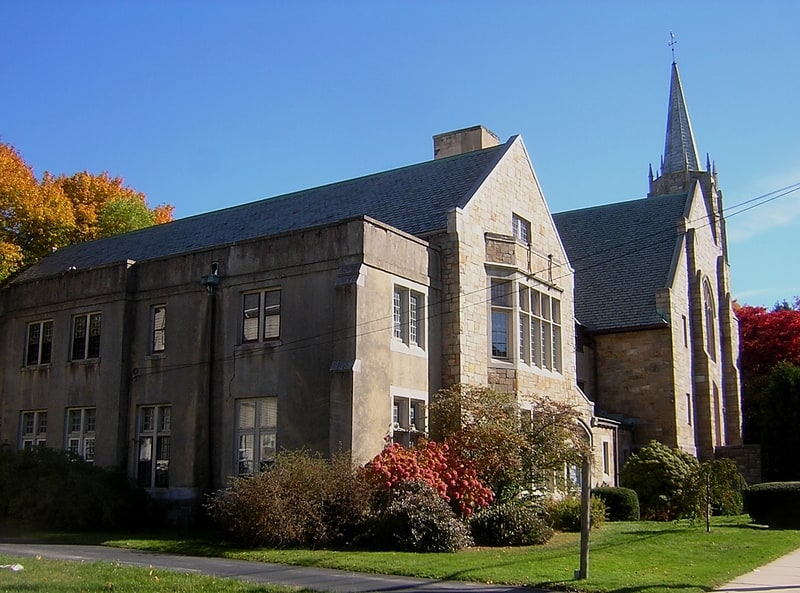
Church building in Quincy, Massachusetts. Wollaston Congregational Church is a historic Congregational church building at 45-57 Lincoln Avenue in Wollaston, Massachusetts. The granite Gothic Revival structure was designed by Smith & Walker, and built in 1926, on the site of an earlier wooden Gothic Revival church. Its parish house, also Gothic in style and designed by the same team, was built in 1915. The congregation was established as a consequence of the Wollaston area's rapid growth beginning in the 1870s.
The building was listed on the National Register of Historic Places in 2008.[24]
Address: 48 Winthrop Ave, 02170-3326 Quincy (Quincy)
Abigail Adams Cairn
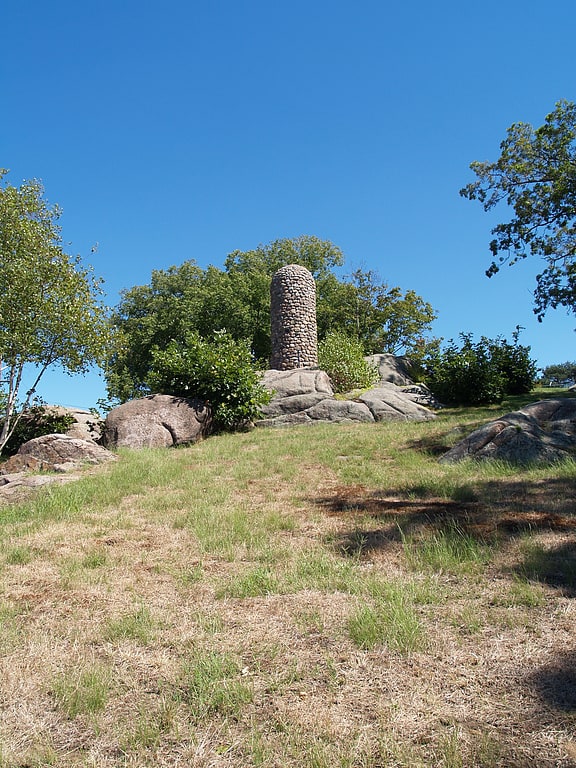
Historical landmark in Quincy, Massachusetts. The Abigail Adams Cairn marks the spot where Abigail Adams and her young son, John Quincy Adams, watched the burning of Charlestown on Saturday, June 17, 1775, during the Battle of Bunker Hill. It is located on Penn's Hill, now at the corner of Franklin Street and Viden Road in Quincy, Massachusetts. Abigail was caring for the four children of Dr. Joseph Warren, then President of the Massachusetts Provincial Congress, as well as her own children, Nabby, John Quincy, Charles, and Thomas Boylston, when word came that Dr. Warren had been killed by British troops. In the afternoon, she walked up Penn's Hill to the rock outcroppings, taking her son John Quincy and Nabby along with her. There they looked out over the distant hills and shoreline, seeing the smoke of Charlestown and hearing the far-off rumble of guns and cannon at Bunker Hill.
The cairn was erected June 17, 1896, by the Adams Chapter of the Society of the Daughters of the Revolution. It contains various marked stones, including one inscribed Concord, another 5th Regt. Co. K. M.V.M., and From Bunker Hill Quarry, June 17, 1896. Its builder was local stonemason John J. Stanton.
A time capsule was discovered inside the cairn in 2008.[25]
First Baptist Church of Wollaston
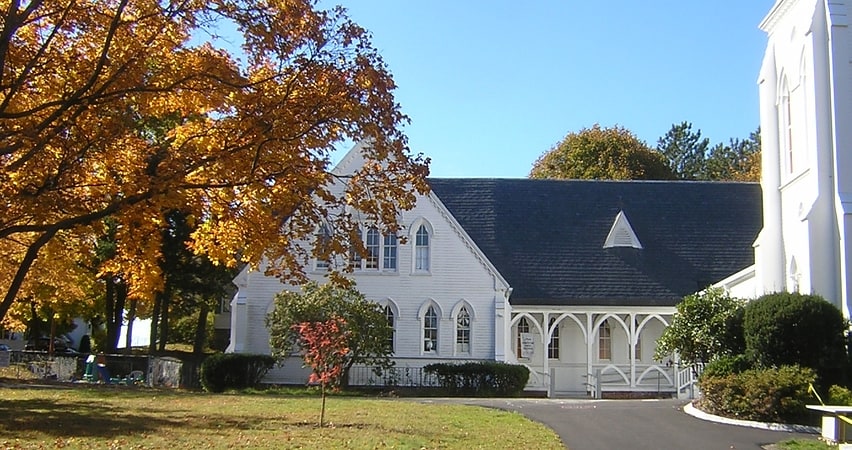
Church building in Quincy, Massachusetts. First Baptist Church of Wollaston is a historic Baptist church building in Wollaston, Massachusetts. Built in 1873 for a new congregation, and repeatedly enlarged, it is a fine example of Gothic Revival architecture, and one of the city's finest remaining wood-frame churches. The church was listed on the National Register of Historic Places in 1989.[26]
Address: 81 Prospect Ave, 02170 Quincy (Quincy)
John Winthrop Jr. Iron Furnace Site
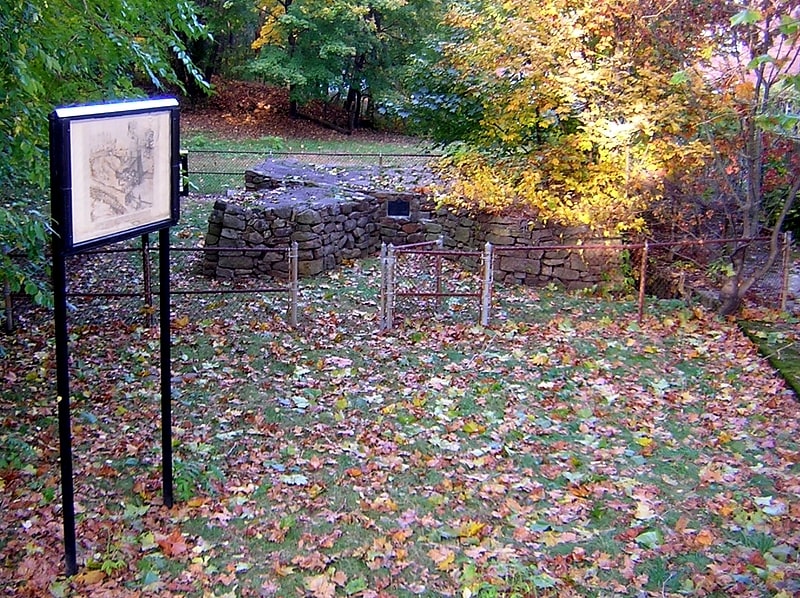
Historical landmark in Quincy, Massachusetts. The John Winthrop Jr. Iron Furnace Site is a historic archaeological site at 61 Crescent Street, Quincy, Massachusetts. The site is called Braintree Furnace in some texts; the West Quincy location at the time of operation was in a part of Braintree, Massachusetts, that later became Quincy. Its importance lies in the fact that it was the first iron blast furnace established in what would become the United States. Furnace Brook, a stream which begins on the eastern slopes of the Blue Hills and meanders for about four miles from southwest to northeast through the middle of Quincy toward Quincy Bay, was named for the works site.
The site was added to the National Register of Historic Places in 1977.[27]
Wollaston Beach
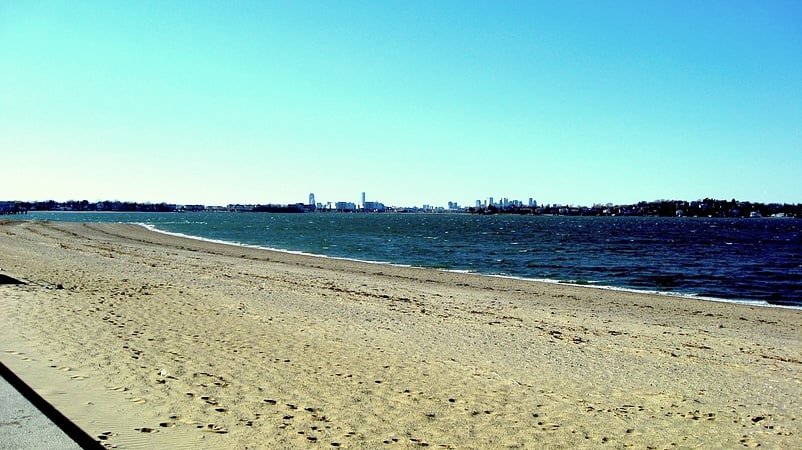
Beach in Quincy, Massachusetts. Wollaston Beach is the largest public beach in the Boston harbor. The beach is located parallel to Quincy Shore Drive in North Quincy, Massachusetts, which was constructed to provide access to the bay beach for Greater Boston. Wollaston beach expands Quincy Bay forming part of Boston Harbor. The northern end of the beach is the Native American historical site, Moswetuset Hummock which is where the original Moswetuset Sac'hem had a tribal council.
Wollaston Beach is now part of the Quincy Shore Reservation which was introduced by the legislative act in 1899. Quincy Shore Drive parallel to the beach was opened on May 30, 1908. It is maintained (waste management) in summer by the Department of Conservation and Recreation (DCR).
Wollaston Beach is the largest in Boston Harbor with roughly 2.3 mi (3.7 km) of shoreline. The promenade stands the entire length of the beach and is often busy with walkers, dog walkers, runners, and casual cyclists. The Wollaston beach promenade has a significant seawall as it is impacted by coastal tides. There are seasonal restaurants that predominately offer battered seafood and become popular on weekends. There is ample parking along the Wollaston Beach promenade. The views from Wollaston beach include Boston, South Boston, Squantum, Houghs Neck, and Nut Island. Boston Harbor Islands are also visible. These islands are; Moon, Long, Georges and Peddocks, Spectacle. The Hull Wind Turbine #1 (200 ft (61 m)) is visible beyond Peddocks. The Hull Wind Turbine #2 (330 ft (100 m)) is visible beyond Houghs Neck.
Based on water quality tests determining levels of enterococcus, currently, the beach is not unacceptable for bathing. This research was conducted in 2019 by the City of Quincy Health Department.
Wollaston Beach has two yacht clubs and is adjacent to the commercial Marina Bay. The southern end of the beach attracts fishing activities. The Squantum Yacht Club and Wollaston Yacht Club have piers to their clubhouse starting at the beach. The Squantum Yacht Club was founded in 1898. The yacht clubs host annual sailing tournaments.[28]
Quincy Shore Drive

Road in Massachusetts. Quincy Shore Drive is a historic parkway in Quincy, Massachusetts. The road is one of a series of parkways built by predecessors of the Massachusetts Department of Conservation and Recreation, to provide access to parks and beaches in the Greater Boston area. Its development was proposed in 1893 by Charles Eliot, who promoted the development of many of the area's parks and parkways. Planning began in 1897, with land acquisition following around 1900. Construction of the 4-mile road was begun in 1903 and completed in 1907.
The northern terminus of Quincy Shore Drive is at Hancock Street (Massachusetts Route 3A), just south of the Neponset River. It runs northeasterly for about 1 mile (1.6 km) through a neighborhood area, reaching the Quincy Shore Reservation at a junction with East Squantum Street. This section is four lanes wide (two in each direction), separated by a tree-lined median, with additional trees on the sides of the roadway providing an attractive canopy. At East Squantum Street the road turns southeasterly to follow the shore for about 2 miles (3.2 km). The inland side of the roadway is lined primarily with houses, while the shore side provides angled parking and beach access, and provides dramatic views of Boston and outer Boston Harbor. This segment is also four lanes, divided by a grassy median.
After passing Fenno Street, the road enters Wollaston Beach Reservation, a city-owned park, which it passes through until it crosses over Black Creek and reaches Furnace Brook Parkway, which provides access to the Blue Hills Reservation. It then runs southerly, away from the shore and through a residential area, reaching its southern terminus at Sea Street.
The road was listed on the National Register of Historic Places in 2003.[29]
United States Post Office–Quincy Main
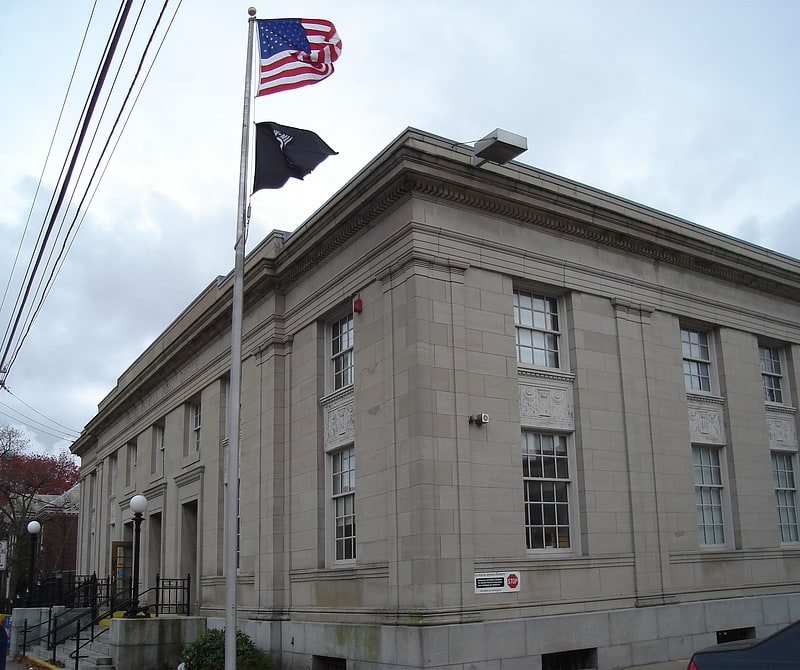
Post office in Quincy, Massachusetts. The US Post Office-Quincy Main is a historic post office at 47 Washington Street in Quincy, Massachusetts. It is a Classical Revival structure, two stories tall, built in 1909 out of limestone. It has corner pilasters, and a central entry section that projects slightly, also with articulating pilasters, and three recessed entryways. The building was originally built to house a variety of federal government offices, as well as providing the first purpose-built home for Quincy's main post office.
The building was listed on the National Register of Historic Places in 1986.[30]
Baypointe Marina

Sailing, Marina
Address: 64 Washington Ct, 02169 Quincy (Quincy)
Forbes Hill Standpipe
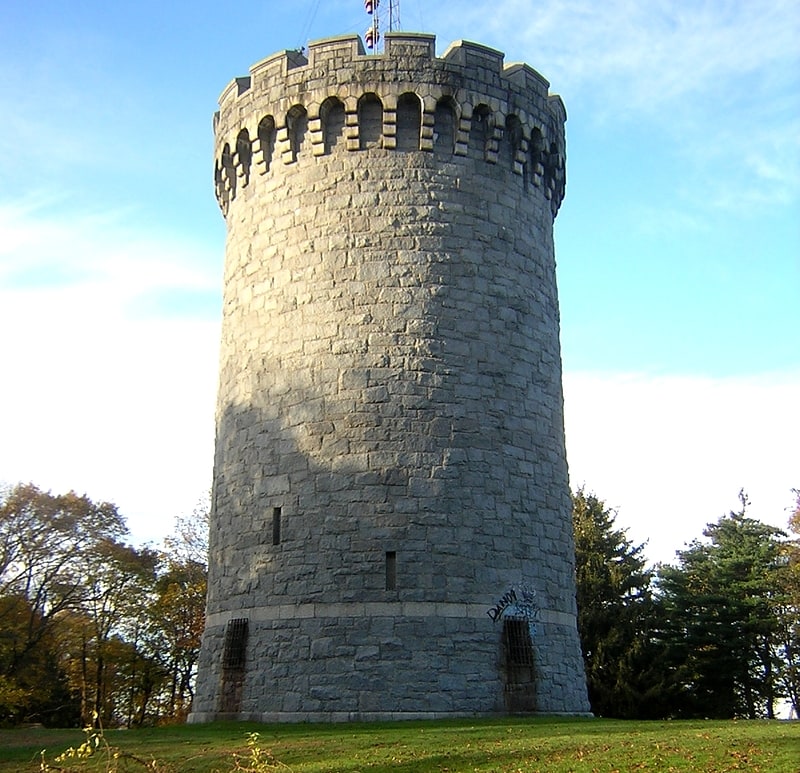
Historical place in Quincy, Massachusetts. The Forbes Hill Standpipe is a historic water tower structure located on Reservoir Road in Quincy, Massachusetts, USA. The tower was built in 1899-1902 to contain a 330,000 US gallons steel water tank. The site originally included an adjacent reservoir that supplied Quincy with water from the Metropolitan Boston Water System. The standpipe was taken out of service in 1955 and the reservoir was filled in.
It was added to the National Register of Historic Places in 1990.[31]
Wollaston Unitarian Church
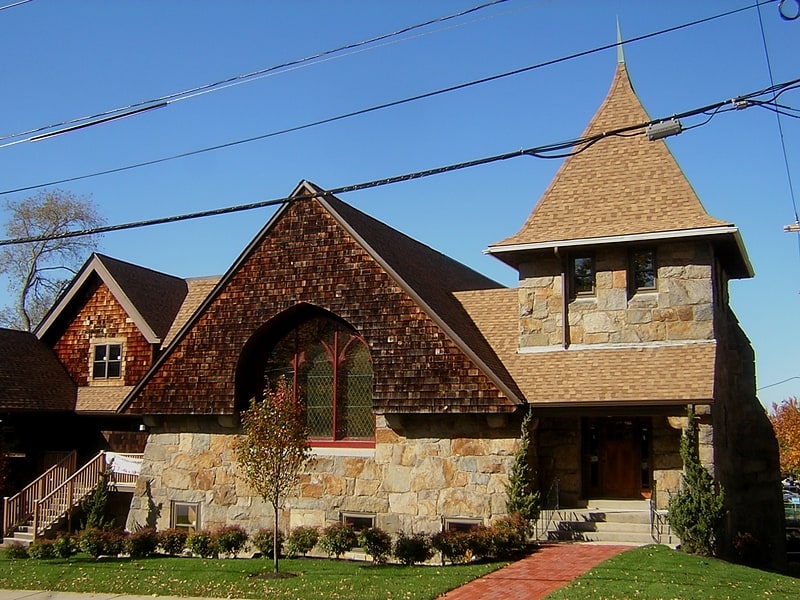
Church in Quincy, Massachusetts. The Wollaston Unitarian Church, more recently a former home of the St. Catherine's Greek Orthodox Church, is a historic church building at 155 Beale Street in Quincy, Massachusetts. Built in 1888, it is a prominent local example of Shingle Style architecture. It was added to the National Register of Historic Places in 1989. The building has been converted to residential use.[32]
Masonic Temple
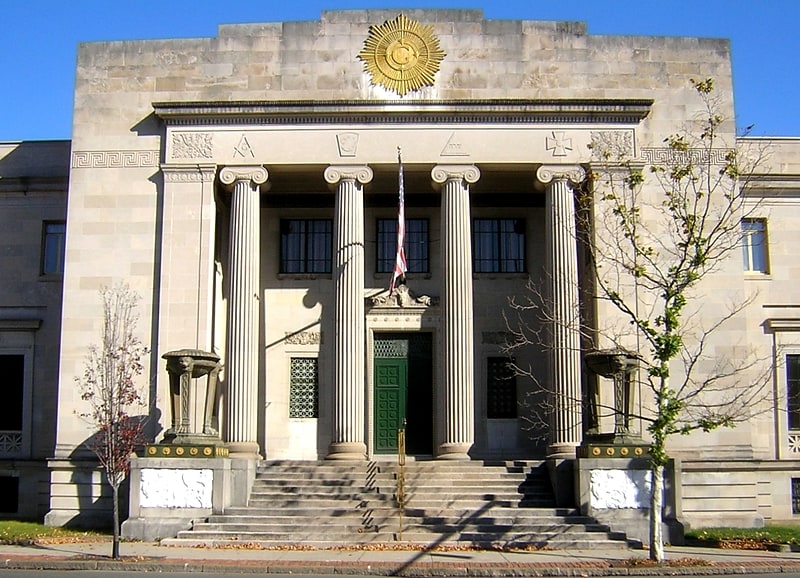
Building in Quincy, Massachusetts. The Quincy Masonic Temple was a historic Masonic temple at 1170 Hancock Street, Quincy, Massachusetts. It was built in 1926 and added to the National Register of Historic Places in 1989. The building was home to three "Blue" Masonic Lodges, two Appendant Bodies: York Rite, Grotto, and two Youth Groups: DeMolay and Rainbow.
Rural Lodge was founded in 1801. Macedonian Lodge was founded in 1892. Milton Lodge was founded in 1922.[33]
House at 32 Bayview Avenue
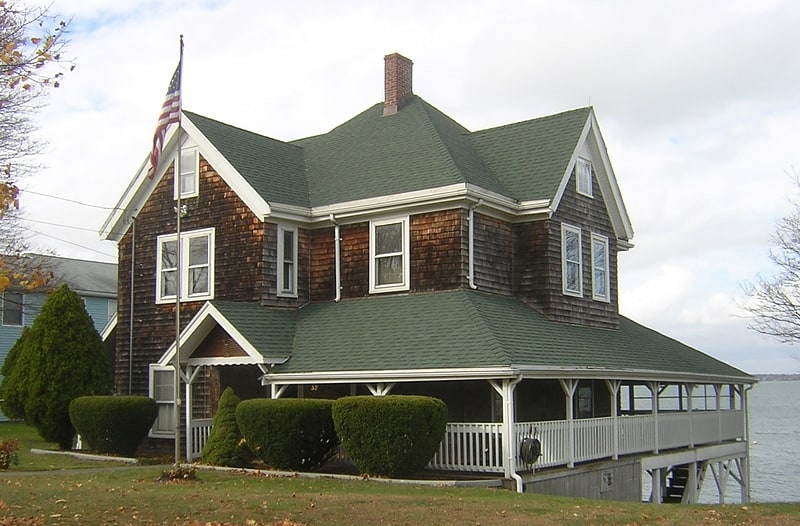
The House at 32 Bayview Avenue in Quincy, Massachusetts, is a modest Queen Anne style house built on the shore during Quincy's development of that area as a summer resort area. It was built in the 1880s, sited to take advantage of the views of the Town River to the north. It features relatively modest stylistic details, including varying gable sizes with bargeboard, and a wraparound porch with square posts and some Stick style woodwork.
The house was listed on the National Register of Historic Places in 1989.[34]